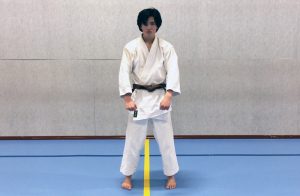Taikyoku Kata is een filosofische term die de macrokosmos aanduidt. De Kosmos vóór de differentiatie in hemel en aarde. Vanaf choas of de leegte. [English version below]
Ultieme trainingskata
Er zijn drie Taikyoku kata. De verschillen worden aangeduid door de numerieke termen, Shodan, Nidan en Sandan). Taikyoku Shodan is een elementaire vorm die bestaat uit twee armtechnieken. Deflectieblok (richtingsveranderende wering) op lager niveau (gedan barai) en frontaanval op middenniveau (chudan oi-tsuki). De kata kent één stand, de voorwaartse stand (zenkutsu dachi). Door zijn eenvoud is de kata gemakkelijk te leren door beginners. Zoals de naam al aangeeft, heeft deze kata een diepgaand karakter. Eentje waar, na beheersing van de kunst van karate, menig gevorderde karate beoefenaar zal terugkeren om het te kiezen als de ultieme trainingskata.
Prototype van een kata
Zodra iemand de Taikyoku kata vaardig kan uitvoeren, kunnen de andere kata relatief gemakkelijk worden geleerd. Hierom moet de Taikyoku kata zowel als elementaire als de ultieme kata worden beschouwd. In feite is de Taikyoku Kata het prototype van een karate kata. De kata bestaat uit een combinatie van het neerwaartse blok en de middenzone vorderende vuiststoot. Dit zijn basistechnieken in elke karatetraining. De hele kata wordt uitgevoerd in de naar voren leunende stand. De kenmerkende lichaamsbewegingen van karate en een basaal gedefinieerd uitvoering lijnpatroon genaamd embu sen onderscheiden de kata.
Embu sen
De bewegingslijn van Taikyoku Shodan behoort tot de I-categorie. De kata bestaat uit vierentwintig bewegingen. De aandachtshouding yoi [*] en de yame-posities aan het eind meegeteld. Beginners doen er ongeveer veertig seconden over om deze kata uit te voeren. Een gevorderde karate student moet dit verkorten met vijf of zes seconden. De I categorie is het meest elementaire kata uitvoering lijnpatroon. De embu sen van andere kata zijn ervan afgeleid.
[Het woord yoi betekent klaar, aandacht, concentratie. De term yame aan het einde van een kata impliceert een status van aanhoudende gereedheid na de kata voltooiing. De termen yoi en yame duiden dus de gereed-positie aan het begin en einde van de kata aan]. (Karate-Do Kyohan, Gichin Funakoshi, 1922, p. 42)
From Karate-Do Kyohan (The Master Text) by Gichin Funakoshi
Taikyoku Shodan is a philosophical term denoting the macrocosm. The cosm before its differentiation into heaven and earth. Hence choas or the void.
There are three Taikyoku forms. All numbered by the ordinal terms, Shodan, Nidan and Sandan. Taikyoku Shodan is an elementary form consisting of two arm techniques. Lower level deflecting block (gedan barai) and middle level front attack (chudan oi-tsuki). It has one stance, the front stance (zenkutsu dachi). Because of its simplicity, the kata is easily learned by beginners. Nevertheless, as its name implies, this form is of the most profound character. One to which, upon mastery of the art of karate, an expert will return to select it as the ultimate training kata.
Taikyoku Kata is prototype
Once one is able to perform the Taikyoku kata with proficiency, he or she can understand the other kata with relative ease. For this reason, the Taikyoku form should be considered elementary as well as the ultimate kata. In fact, the Taikyoku Kata is very prototype of a karate kata. It has a combination of the down block and the middle level front punch. Basic techniques that are practiced in any training. The kata is performed in the front stance. The typical body movements of karate, and a defined line of movement called embu sen distinguish the kata.
Embu sen
The line of movement of Taikyoku Shodan is of the I category. Taikyoku kata consists of twenty-four movements. The ready yoi [*] and the yame postitions included. Beginners take about forty seconds to complete the kata. Whereas an advanced student should shorten this with five or six seconds. It is worthwhile to note that the I category is the most basic of the lines of movement in kata. Others being derived from it.

[Yoi means ready. The term yame at the end of a kata includes an implication of readiness. Terms like yoi and yame designate the ready position at the beginning and end of the kata]. Source: Karate-Do Kyohan, Gichin Funakoshi, 1922, p. 42).


